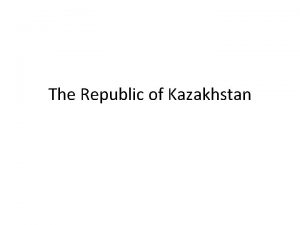Reservoir Characterization of a Kazakhstan Reservoir Integration of

- Slides: 1

Reservoir Characterization of a Kazakhstan Reservoir: Integration of Seismic and Production Information Ph. D in Petroleum Engineering Karwan Al-Mala Khudhur (karwansaadon@gmail. com) Introduction One of the important R&D challenges on reservoir characterization is the integration of geological data, seismic information and production data to model internal properties of complex and very heterogeneous reservoirs. In this study the characterization of main properties of one real reservoir (Kazakhstan) is approached with the following a sequential outline: seismic, geological information and well log data are used in a integrated global seismic (acoustic) inversion to generate uncertainty models of main properties, acoustic inversion, porosity and permeability. In a second step, these models are converted to the uncertainty space of dynamic production data. Objectives i) Spatial characterization of rock properties of the oil reservoir - porosity, permeability, net pay, and decisions making regarding the development of the field. ii) Create high resolution models of such properties, conditioned to seismic, geology conceptual model and well log data. Uncertainty assessment of such models in a static referential. iii) Create a dynamic behavior for the reservoir to predict the flow of fluids (oil, water, and gas) and quantify the uncertainty and risk with dynamic responses. Methodology Reservoir characterization (Global Stochastic Inversion) 1‐ Generate a set of initial images of acoustic impedances by using direct sequential simulation (DSS). Permeability K Simulation 1 Real Seismic slice at Y 389 AI slice at Y 389 Permeability K Simulation 16 Correlation slice at Y 389 Permeability K Simulation 32 at Z 58 Synthetic slice at Y 389 Permeability K Simulation 16 at Z 58 3‐ Evaluate the match of the synthetic seismograms, of the entire 3 D image, and the real seismic by computing, for example, local correlation coefficients. Permeability is characterized based on the Porosity cubes and Permeability from well data as secondary image, direct sequential co-simulation is applied. Permeability K Simulation 1 at Z 58 2‐ Create the synthetic seismogram of amplitudes, by convolving the reflectivity, derived from acoustic impedances, with a known wavelet. Figure-1 -Real Seismic and Results of GSI: AI, C C, SY cubes, with their slices at Y dimension Figure-3 -Characterization of Permeability based on the Porosity cubes and Permeability from well data, direct sequential cosimulation is applied 4‐ Transforming of Acoustic Impedance (AI) cube into Porosity cubes by using an experimental relationship. Through the use of the AI cube as secondary information and one correlation coefficient (Phie/AI) as local co‐regionalization model in co‐simulation process to access uncertainty and later on based on Porosity models, Permeability models are produced. Figure -3 -Slices of Porosity and Permeability at different simulations Figure-2 - transforming AI to Porosity cube at different simulations Last step is to create a dynamic model for resulted Porosity and Permeability to predict the uncertainty and evaluate the risk of different development policies. Supervisor Professor : Amílcar Soares Programa Doutoral Simulation # 16 Permeability Z 58 Correlation slice at Z 58 Simulation # 1 Permeability Z 58 Real Seismic Z 58 Best AI cube iteration 6 simulation #19 At Z 58 Simulation #16 Total Porosity Z 58 Simulation #1 Total Porosity Z 58 Synthetic Cube at Z 58

